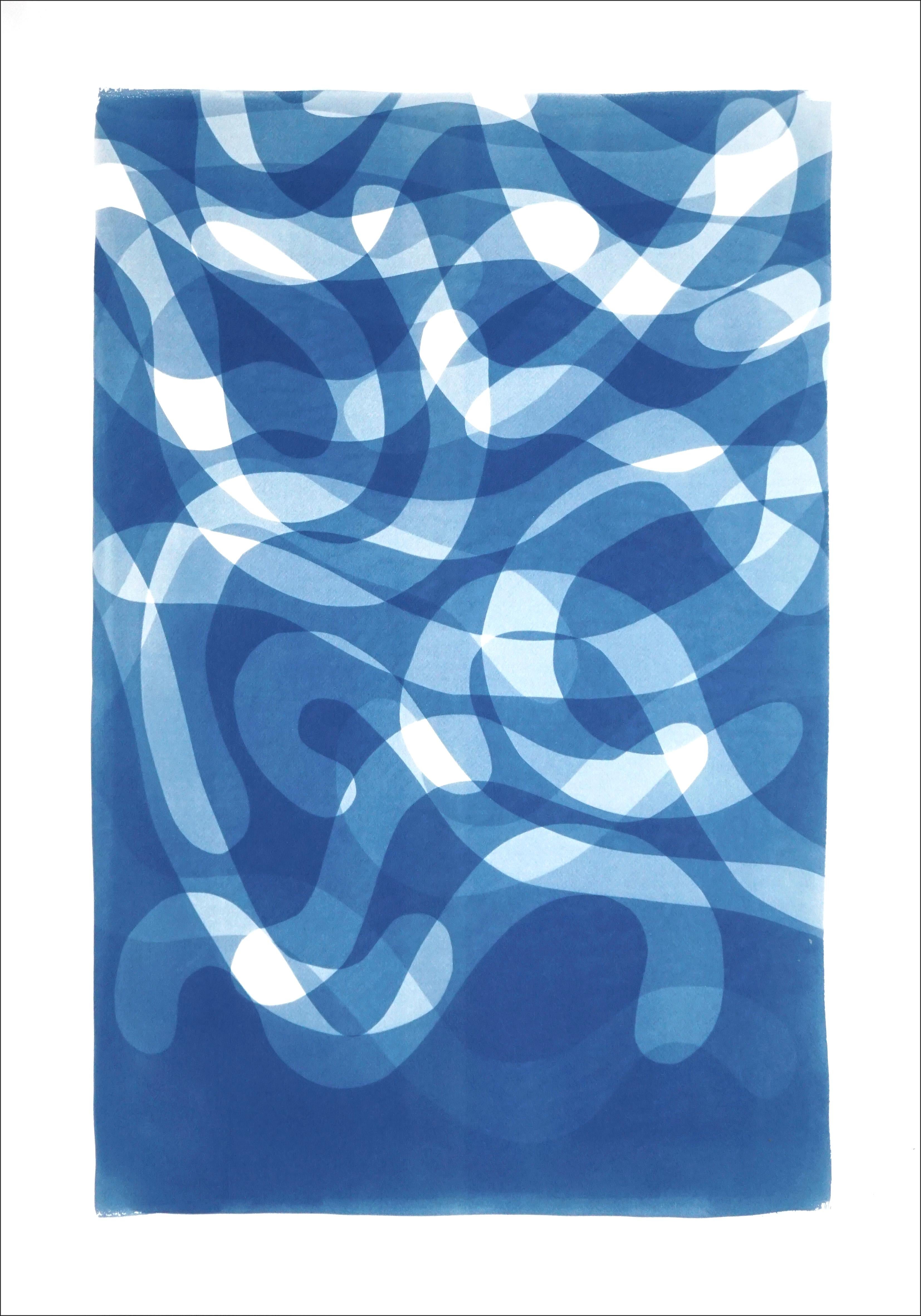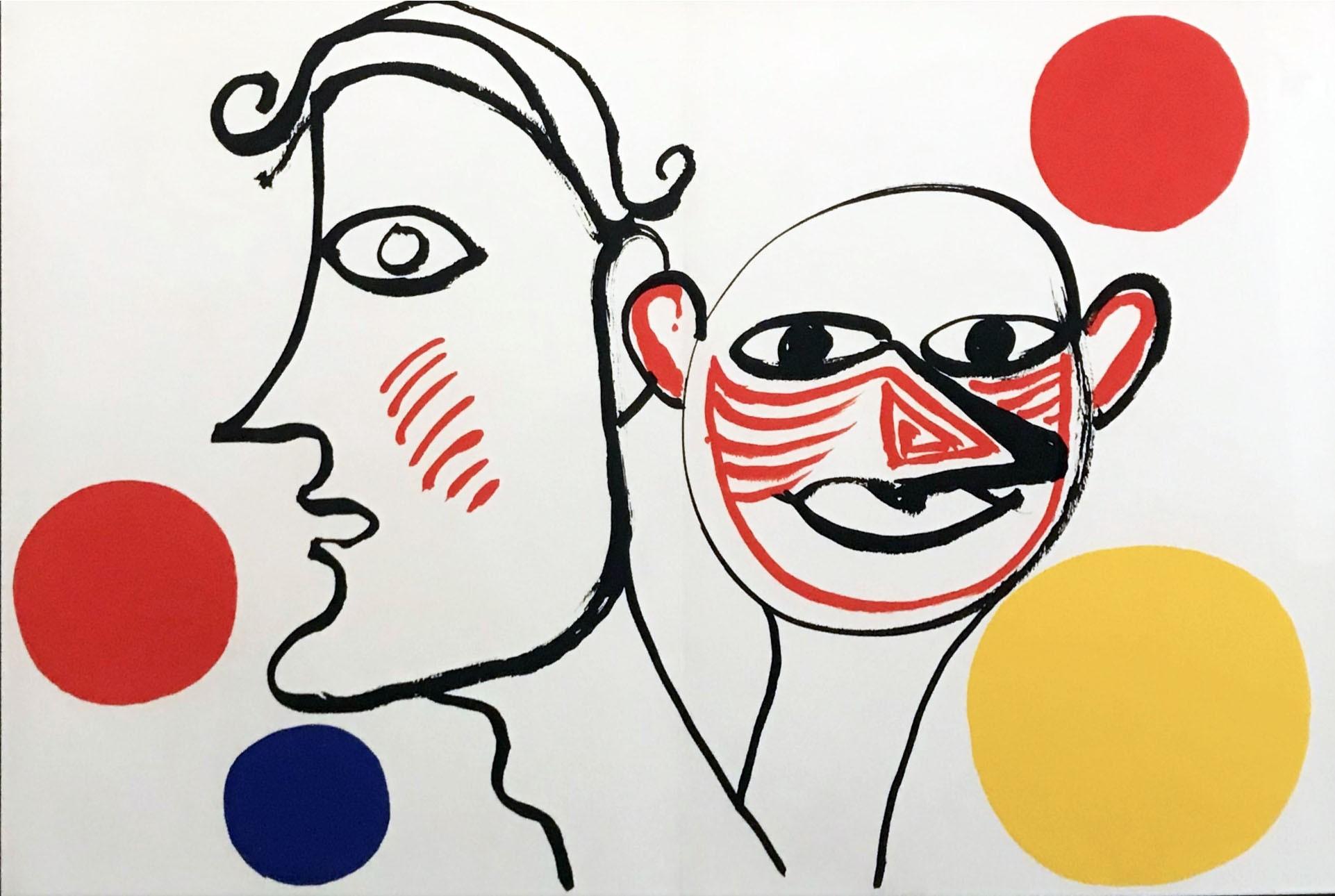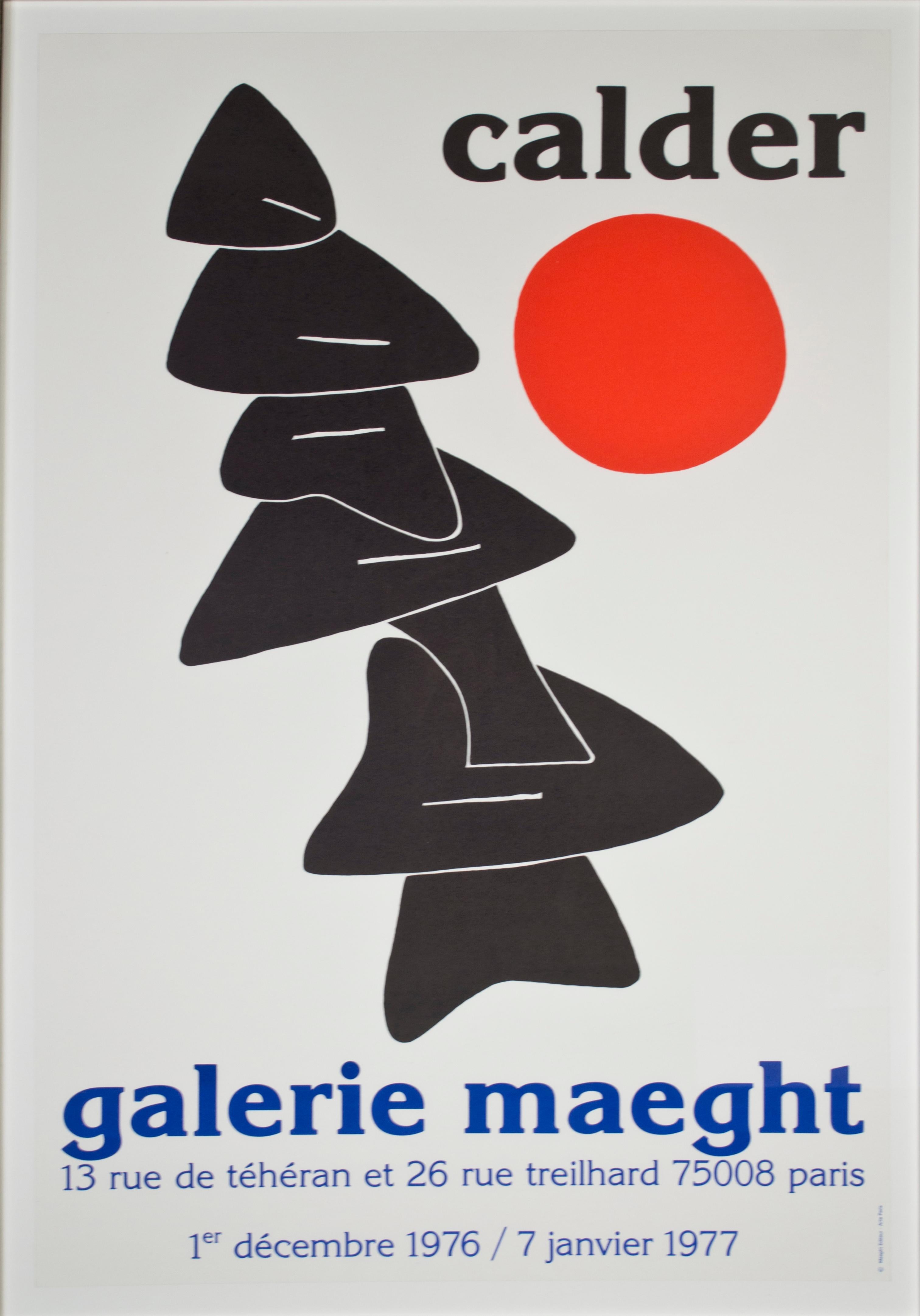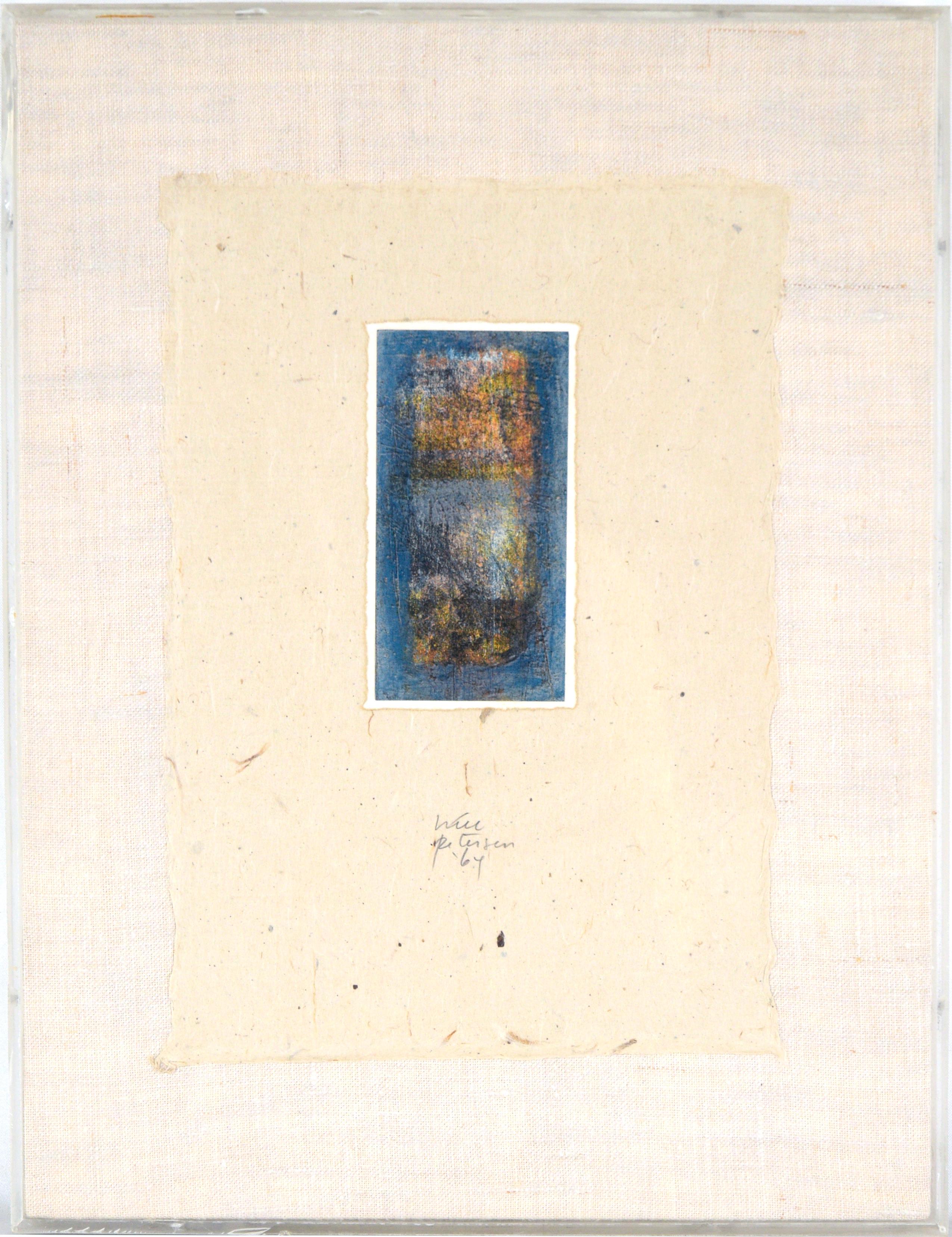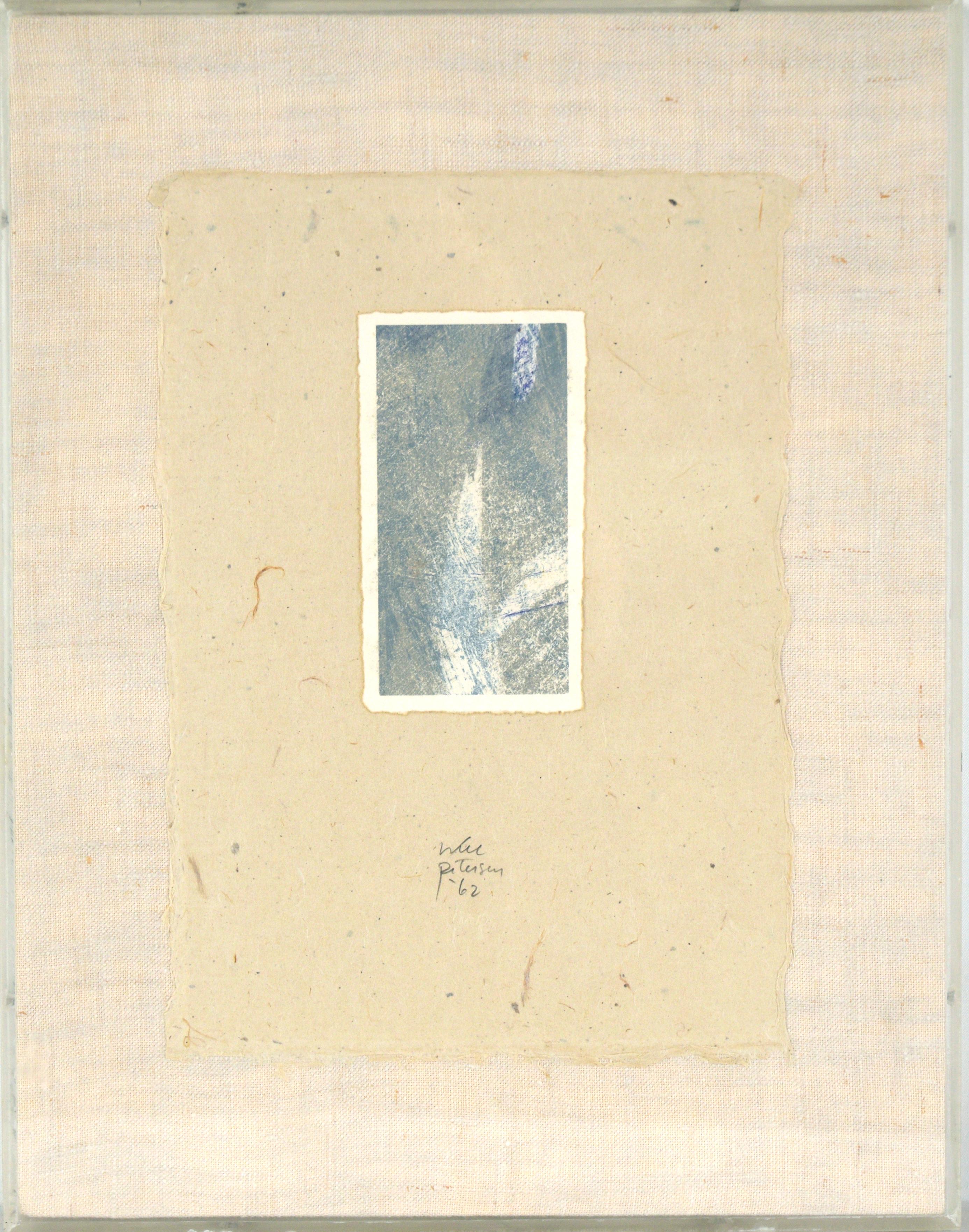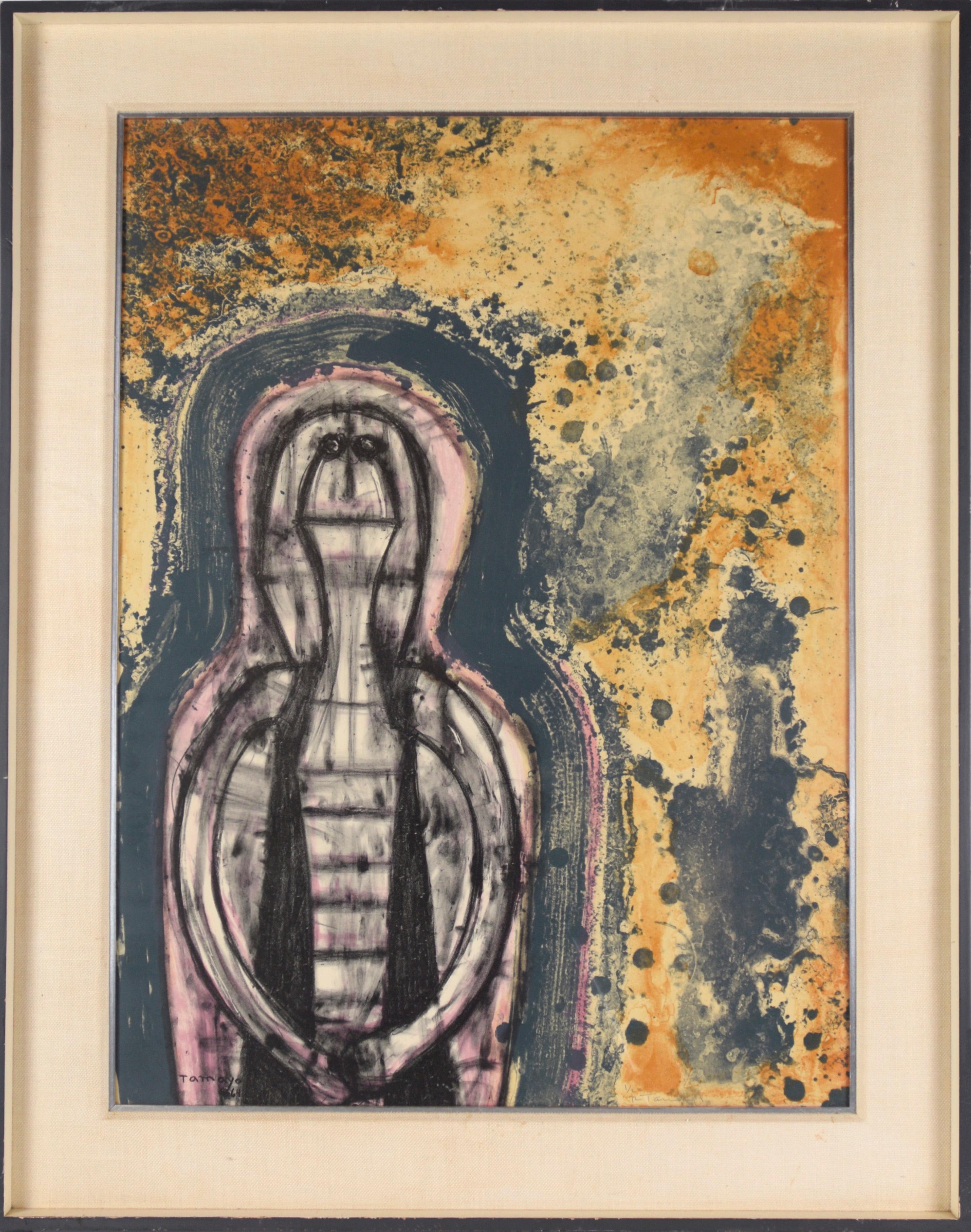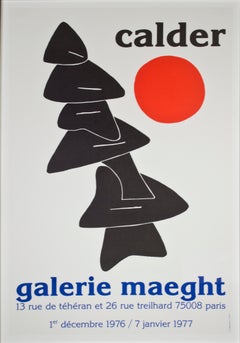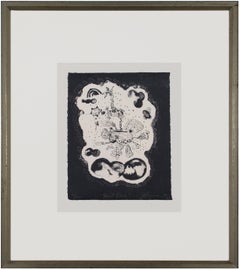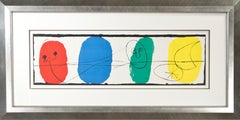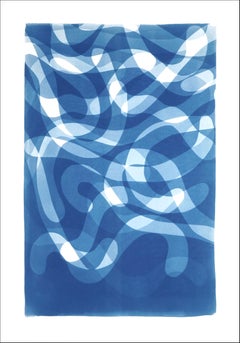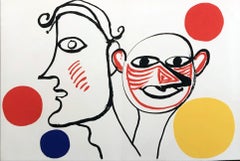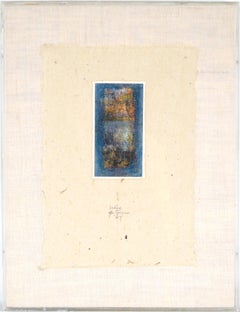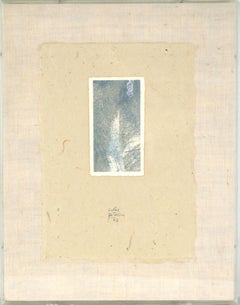Items Similar to "Galerie Maeght, " Graphic Color Lines Lithograph Poster by Jean Rene Bazaine
Want more images or videos?
Request additional images or videos from the seller
1 of 7
Jean Rene Bazaine"Galerie Maeght, " Graphic Color Lines Lithograph Poster by Jean Rene Bazaine1974
1974
About the Item
"Galerie Maeght" lithograph poster by Jean Rene Bazaine. This poster holds Bazine's name in harsh orange lines near the top of the piece. Diagonally bisecting the b and a in Bazaine is a teal line. Bellow this horizontally against the white backgrounds are two lines, one painted yellow and the other blue.
Image: 29 x 21 in
Jean Bazaine was a French painter, designer of stained glass windows, and writer. He was the great great grandson of the English Court portraitist Sir George Hayter. In 1949/1950 he had his first major one man show at the Galerie Maeght, who remained his art dealer thenceforth. From then on it was a steady progress of major exhibitions: Bern, Hanover, Zürich, Oslo... 1987 a retrospective exhibition in Galerie Maeght, 1988 a retrospective of his drawings in the Musée Matisse and finally in 1990 the Exposition Bazaine in the Galeries Nationales du Grand Palais, Paris., which was accompanied by the reissue of his major texts on painting in art theory as Le temps de la peinture (Paris, Aubier 1990). "The motley crowds of international tourists and souvenir-shoppers who fill the ancient streets of the Latin Quarter in Paris spend most of their time admiring the open-air displays of seafood outside the Greek restaurants in the rue de la Huchette. They ignore the beautiful church of St Severin in the same street, for have they not already "done" Notre Dame? So they miss one of the most wonderful series of stained-glass windows in France: Jean Bazaine's vivid, dynamic works irradiating the sombre ambulatory and apsidal chapels. These windows represent the seven sacraments of the Church, portrayed as essential forms from nature in all its glory and symbolising Water, Fire and Light, sacred emblems of Divine Grace. An appropriate biblical verse is inscribed beneath each. Only Pierre Soulages with his "luminous black" windows at l'Abbaye de Conques (1998) can stand comparison with the majesty of these contemporary works by Bazaine, created between 1965 and 1970. Bazaine was fortunate in his friends. He received at an early stage in his student career support and advice from another master colourist, Pierre Bonnard. In his youth he knew Leger, Braque, James Joyce and Marcel Proust. One of his great personal friends was Jean Fautrier, with whom he shared his first exhibition in 1930. His work gradually developed as a form of bold tachisme - brilliantly composed but well-controlled "splashes" of sumptuous colour. He rejected the term "abstract" which he considered a denial of the essentially intimate relationships between art and reality. He quoted his friend Braque: "The canvas must efface the idea behind it." In 1941, during the Nazi occupation, at a time when Hitler was destroying many works of modern art, Bazaine had the courage to organise in Paris a first "avant-garde" exhibition of 20 French artists. In 1948, he wrote his first book, an unpedantic, unacademic view of contemporary painting, Notes sur la peinture d'aujourd'hui. He quotes Braque on Cezanne: "He's a painters' painter - other people think it's unfinished." Bazaine, too, reverenced Cezanne: Three lines drawn by Cezanne overturn our whole concept of the world, proclaim the liberty of man, his courage. The great painters have never had any other aims. The painter says: "I exist, therefore you exist. I am free, therefore you are free. Or at least he tries to. It's his one aim in life." After the Second World War, Bazaine produced vast compositions with virtuoso colour structures, mostly with references to nature, like the breathtaking Vent de mer (1949, now in the Museum of Modern Art, Paris) and Orage au jardin (1952, now in the Van Abbemuseum at Eindhoven). His Earth and Sky (1950) is in the Maeght Foundation at Saint Paul de Vence. One of his greatest works, L'Arbre tenebreux (1962), was sold to the Sonja Henie-Niels Foundation in Norway. These enormous, evocative representations of the forces of nature were always preceded by numerous sketches, drawings and colour value notations that are in themselves fascinating insights into the painter's techniques in the production of apparently spontaneous burst of colour and contrasts of movement and subtleties of tone. Bazaine was a natural choice for large-scale architectural and literary collaborations. He made magnificent illustrations for poetry by André Frenaud, René Char and Jean Tardieu: unlike most painters, he was a passionate lover of poetry, and could express the very essence of a poem in an astonishing feat of almost mediumistic artistic insight into the subject. He created the immense mosaic composition for the Unesco building in Paris (1960), as well as decorations for the transatlantic liner France (1962) and the Maison de la Radio (1963). His monumental gift can be found also in more mundane surroundings like the Cluny metro station. But it is as an inspired creator of works enriching the entire history of modern religious art that Bazaine will best be remembered, by believers and non-believers alike: the windows in the church at Asay (1943-47) in Savoie, the façade mosaics (1951) and windows (1954) of the church at Audincourt in the Jura (1954), the church of Villeparisis (1961) and a reception centre at Noisy le Grand (1955). He also devised tapestries, like the Blasons des douze mois (1975). Among his writing on art, there is Exercise de la peinture (1973) and La Temps de la peinture, a collection of all his writings on painting and the arts in general (1985). Jean Bazaine was a great master, but a humble one. He once confessed that he thought of suicide at least three times every day, so in despair did he feel about his work. One of his favourite quotations in Notes sur la peinture d'aujourd'hui comes, surprisingly, from the classicist Jacques Louis David: I would like a painter, at the end of 20 years of work, to begin each new painting in a state of the same indecision as when he started. And as epigraph to his L'exercise de la peinture Bazaine wrote: Linked for 20,000 years - and for just as long in times to come - to the destiny of man, painting has not lost any of its mystery. And this essay cannot hope to explain it. But the explanation is in every one of his paintings." Article Written by James Kirup
- Creator:Jean Rene Bazaine
- Creation Year:1974
- Dimensions:Height: 29 in (73.66 cm)Width: 21 in (53.34 cm)
- Medium:
- Movement & Style:
- Period:
- Condition:
- Gallery Location:Milwaukee, WI
- Reference Number:Seller: 204d1stDibs: LU60535511092
About the Seller
4.9
Gold Seller
Premium sellers maintaining a 4.3+ rating and 24-hour response times
Established in 1966
1stDibs seller since 2017
429 sales on 1stDibs
Typical response time: 2 hours
- ShippingRetrieving quote...Shipping from: Milwaukee, WI
- Return Policy
Authenticity Guarantee
In the unlikely event there’s an issue with an item’s authenticity, contact us within 1 year for a full refund. DetailsMoney-Back Guarantee
If your item is not as described, is damaged in transit, or does not arrive, contact us within 7 days for a full refund. Details24-Hour Cancellation
You have a 24-hour grace period in which to reconsider your purchase, with no questions asked.Vetted Professional Sellers
Our world-class sellers must adhere to strict standards for service and quality, maintaining the integrity of our listings.Price-Match Guarantee
If you find that a seller listed the same item for a lower price elsewhere, we’ll match it.Trusted Global Delivery
Our best-in-class carrier network provides specialized shipping options worldwide, including custom delivery.More From This Seller
View All"Stabile with Red Sun Galerie Maeght" Lithograph Poster
By Alexander Calder
Located in Milwaukee, WI
"Stabile with Red Sun Galerie Maught" is a color lithograph poster. The Stabile is a black topsy-turvy statue taking up most of the piece. A red sun sits to the right of the black st...
Category
1970s Post-Modern Abstract Prints
Materials
Lithograph
"Don't Wine, " Original Surreal Serigraph by Paula Schuette Kraemer & Bill Weege
By Paula Schuette Kraemer
Located in Milwaukee, WI
"Don't Wine" is a mixed media piece, predominately a serigraph, by Paula Schuette Kramer and Bill Weege. Both artists signed in pencil in the lower right, and the title is in the lower left. It is one of a an edition of 50. The print is an explosion of bright colors, but red, blue, and green dominated the composition as they fade through the background. A blue figure climbs up a ladder out of an apple, hefting a large wine bottle overhead, which they pour out into the sea of wine. A man, woman, and long-necked orange bird also look out from the apple, reading for the stem of a floating bunch of green grapes. A group surrounds the grapes with their heads and shoulders above the water, eating the fruit. Birds fly through the background, dodging wine glasses and a vase of flowers that seem to be tumbling from a flying carpet. The entire image feels very surreal.
Art size: 12" x 10"
Frame size: 19 1/4" x 17"
Paula Schuette Kraemer is an independent artist living in Madison, Wisconsin...
Category
1990s Post-Modern Abstract Prints
Materials
Mixed Media
'Mad Dash' original lithograph signed by Joseph Rozman
By Joseph Rozman
Located in Milwaukee, WI
'Mad Dash' is a print that exemplifies the work of Joseph Rozman during the 1970s, moving beyond the playful pictographs of the previous decade and morphing into an increasingly surr...
Category
1970s Surrealist Figurative Prints
Materials
Lithograph
Foldout from catalogue for 'Terres de grand feu' lithograph by Joan Miró
By Joan Miró
Located in Milwaukee, WI
Joan Miró produced this original lithograph especially for the catalogue for an exhibition of his and Josep Llorens Artigas' collaborative work at the Pierre Matisse Gallery, New Yo...
Category
1950s Abstract Abstract Prints
Materials
Lithograph
Cover from 'Miró Lithographs IV, Maeght Publisher' original print by Joan Miró
By Joan Miró
Located in Milwaukee, WI
This original lithograph is one of six produced by Joan Miró especially for the fourth volume of the catalogue of his lithographs. These are excellent examples of his later work and ...
Category
1980s Abstract Abstract Prints
Materials
Lithograph
'Winter Silhouettes, ' offset lithograph by Schomer Lichtner
By Schomer Lichtner
Located in Milwaukee, WI
'Winter Silhouettes,' a small and delicate print, is an original offset lithograph by the Milwaukee artist Schomer Lichtner. The composition displays registers of foliage, emerging from the white of the paper as though emerging from the snow-covered ground. The artwork is thus plays with the materials of printmaking; the paper is both the support and the primary indication of the season. The subtle texture of the tooth of the paper also adds life to the image, giving the snow a wind-swept, creature trodden surface. The free forms of the grasses and leaves resemble the lyrical mid-century works of the French artist Henri Matisse, which combined with these material concerns demonstrate Lichter's modern sensibilities.
3.75 x 2.75 inches, image
5.5 x 4.5 inches, paper
10 x 8 inches frame
Signed and dated in the stone, lower right
Framed to conservation standards in a shadow-box style mounting, using 100 percent rag matting, museum glass, and housed in a cherry wood moulding
Overall excellent condition; some toning to edges of paper; some minor abrasions to frame
Milwaukee artist Schomer Lichtner was well known for his whimsical cows and ballerinas and abstract imagery. He and his late wife Ruth Grotenrath, both well-known Wisconsin artists, began their prolific careers as muralists for WPA projects, primarily post offices.
Lichtner also painted murals for industry and private clients. Schomer was a printmaker and produced block prints, lithographs, and serigraph prints. His casein (paint made from dairy products) and acrylic paintings are of the rural Wisconsin landscape and farm animals. He became interested in cows when he and Ruth spent summers near Holy Hill in Washington County. According to David Gordon, director of the Milwaukee Art Museum, Schomer Lichtner had a tremendous joie de vivre and expressed it in his art.
Schomer Lichtner was nationally known for his whimsical paintings and sculptures of black- and white-patterned Holstein cows and elegant ballerina dancers. Lichtner also painted all sorts of combinations of beautiful women, flowers and country landscapes. James Auer, former Milwaukee Journal Sentinel art critic, said that his art eventually "exploded into expressionistic design elements with bold, flat areas of color and high energy that anticipated Pop Art." Auer went on to describe Lichtner’s work as full of "wit, vigor and virtuosity."
As early as 1930, Lichtner’s work was shown at the prestigious Carnegie International Exhibition in New York and at museums throughout the Midwest. As a student, he was a protégé of another icon of 20th century American art, Gustave Moeller.
Lichtner and his wife, Ruth Grotenrath (1912-1988), are celebrated as Milwaukee’s first couple of painting and are regarded as major Wisconsin artists. Lichtner’s impressive production, perseverance, longevity, and positive approach to his life and art made him and his work distinctive and much loved by his many admirers. His work is currently represented in collections at the Milwaukee Art Museum, the John Michael Kohler Art Center, the West Bend Museum, and in the collections of many individuals. Books on the lives and art work of both Lichtner and Grotenrath are in progress and it is anticipated that they will be published next year.
Schomer Lichtner passed away on May 9, 2006 at the age of 101. He continued to amaze and create with his whimsical paintings of ballerinas...
Category
1960s American Modern Landscape Prints
Materials
Black and White, Lithograph
You May Also Like
Falling Swirls, Organic Curvy Layers in Blue Tones, Handmade Cyanotype on Paper
By Kind of Cyan
Located in Barcelona, ES
This is an exclusive handprinted unique cyanotype that takes its inspiration from the mid-century modern shapes.
It's made by layering paper cutouts and different exposures using uv-...
Category
2010s Post-Modern Abstract Prints
Materials
Watercolor, Rag Paper, Lithograph
Derriere le Miroir #221
By Alexander Calder
Located in Washington, DC
Artist: Alexander Calder
Title: Derriere le Miroir #221
Portfolio: Derriere le Miroir #221
Medium: Lithograph in colors
Date: 1975
Edition: Unnumbered
Sheet Size: 15" x 22"
Image Siz...
Category
1970s Post-Modern Abstract Prints
Materials
Lithograph
Delicate Abstract Lithograph with Blue and Orange
Located in Soquel, CA
Delicate Abstract Lithograph with Blue and Orange by American Beat artist Will Peterson (1928-1994.)
This lithograph blends the linework and movement of abstract impressionism with a color field-esque composition. The vibrant orange rectangle in the center of the piece is bracketed by a contrasting cobalt border. The edges of these shapes are softened by delicate linework and areas of hazy lighter blues and whites. Overall, this creates an atmospheric and striking piece.
Lithograph is printed on wove paper which is fixed to a larger piece of handmade paper containing the artists signature and a small embossing found on his other pieces from this time period. This paper is displayed on top of a linen covered board with sturdy wood edges and a plexiglass over over the entire piece.
Will Peterson was born in Chicago in 1928 to German immigrant parents. He contracted Polio when he was in High School and thus spent much of his early years ill. During this time he started working as a cartoonist for his high school’s paper. He started his official art studies at Wilber Wright College in Chicago and later earned a BA and a MA at Michigan State University. Here he studied print making and lithography under John S. deMartelly. He began enjoying artistic success while still in graduate school, exhibiting at the Detroit Art Institute, the Terry Art Institute, the National Print Exhibition, and the Boston Printmakers.
Peterson was drafted into the army in 1952 and thus spent time in Korea and Japan. His time as an educational specialist in Hokkaido was a formative experience for him and his interest in Japanese calligraphy and other arts influenced his later work. Upon returning to the United States, he moved to Oakland, California. He became involved with the beat movement and after founding the Bay Printmakers Society with fellow artist Mel Strawn...
Category
1960s Post-Modern Abstract Prints
Materials
Handmade Paper, Lithograph
Delicate Abstract Lithograph in Pale Blues and Greys
Located in Soquel, CA
Delicate Abstract Lithograph in Pale Blues and Greys by American Beat artist Will Peterson (1928-1994.)
This lithograph features a soft warm grey background overlayed with light blue shading and line work. In the bottom center of the piece is a spiky white shape. The colors and shapes are subtle and feel reminiscent of ice.
Lithograph is printed on wove paper which is fixed to a larger piece of handmade paper containing the artists signature and a small embossing found on his other pieces from this time period. This paper is displayed on top of a linen covered board with sturdy wood edges and a plexiglass over over the entire piece.
Will Peterson was born in Chicago in 1928 to German immigrant parents. He contracted Polio when he was in High School and thus spent much of his early years ill. During this time he started working as a cartoonist for his high school’s paper. He started his official art studies at Wilber Wright College in Chicago and later earned a BA and a MA at Michigan State University. Here he studied print making and lithography under John S. deMartelly. He began enjoying artistic success while still in graduate school, exhibiting at the Detroit Art Institute, the Terry Art Institute, the National Print Exhibition, and the Boston Printmakers.
Peterson was drafted into the army in 1952 and thus spent time in Korea and Japan. His time as an educational specialist in Hokkaido was a formative experience for him and his interest in Japanese calligraphy and other arts influenced his later work. Upon returning to the United States, he moved to Oakland, California. He became involved with the beat movement and after founding the Bay Printmakers Society with fellow artist Mel Strawn...
Category
1960s Post-Modern Abstract Prints
Materials
Handmade Paper, Lithograph
"Personaje en un Cueva" (Personage in a Cave) Surrealist Lithograph
By Rufino Tamayo
Located in Soquel, CA
"Personaje en un Cueva" (Personage in a Cave) Surrealist Lithograph by Rufino Tamayo (b. 1899 d. 1991.)
Abstract figurative lithograph featuring a textured background and bold figur...
Category
1960s Post-Modern Figurative Prints
Materials
Paper, Lithograph
Abstract Color Field Lithograph in Pale Blue and Brown
Located in Soquel, CA
Abstract Color Field Lithograph in Pale Blue and Brown by American Beat artist Will Peterson (1928-1994.)
This lithograph blends the linework and movement of abstract impressionism with a color field-esque composition. A long copper-brown rectangle shines through from the bottom layer of the colors. It is then crossed in multiple places by black linework and hatching. Around this shape a pale cornflower blue acts as a frame and crosses the brown shape in the center. The addition of the cool black and blue tones creates a sense of warmth in the underlying shape.
Lithograph is printed on wove paper which is fixed to a larger piece of handmade paper containing the artists signature and a small embossing found on his other pieces from this time period. This paper is displayed on top of a linen covered board with sturdy wood edges and a plexiglass over over the entire piece.
Will Peterson was born in Chicago in 1928 to German immigrant parents. He contracted Polio when he was in High School and thus spent much of his early years ill. During this time he started working as a cartoonist for his high school’s paper. He started his official art studies at Wilber Wright College in Chicago and later earned a BA and a MA at Michigan State University. Here he studied print making and lithography under John S. deMartelly. He began enjoying artistic success while still in graduate school, exhibiting at the Detroit Art Institute, the Terry Art Institute, the National Print Exhibition, and the Boston Printmakers.
Peterson was drafted into the army in 1952 and thus spent time in Korea and Japan. His time as an educational specialist in Hokkaido was a formative experience for him and his interest in Japanese calligraphy and other arts influenced his later work. Upon returning to the United States, he moved to Oakland, California. He became involved with the beat movement and after founding the Bay Printmakers Society with fellow artist Mel Strawn...
Category
1960s Post-Modern Figurative Prints
Materials
Handmade Paper, Lithograph
